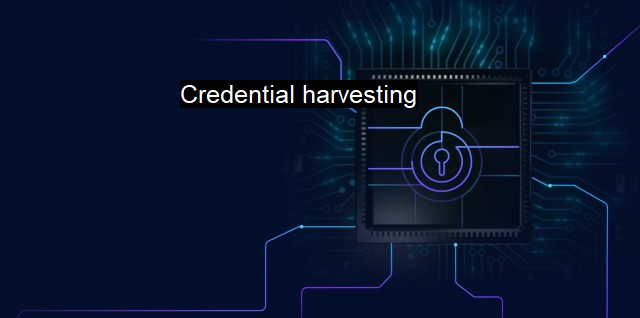What is Credential harvesting?
Combating Credential Harvesting: Protecting Yourself Against the Latest Cybersecurity Threats
Credential harvesting is a deceptive activity that has become significantly prevalent in the digital domain, especially in the practices related to cybersecurity and antivirus systems. credential harvesting involves techniques where malicious actors seek to collect user credentials such as usernames, passwords, and personal identification pins, with a motive to execute unauthorized access to confidential information.Generally, credential harvesting is undertaken through various online methods which require high levels of cybersecurity vigilance. Strategies like phishing, where fraudulent attempts are made to obtain sensitive user information under the disguise of a trustworthy entity, are commonly used. For instance, a user may receive an email that duplicates the appearance of an organization they trust, luring them into entering their username and password on a counterfeit login page. Such deceptive messages can make victims believe they are dealing with the actual organization, causing them to willingly reveal their credentials which are then harvested by fraudsters.
Credential harvesting also uses advanced malware for gathering user data. The implementation of these threats involves embedding malicious code in an individual's computer system, under the radar of local security-antivirus software, to log the user’s keystrokes. This strategy is commonly referred to as keylogging. Since the software records each keystroke typed on the keyboard, it is capable of capturing all typed-in usernames, passwords and other sensitive data. Such malware can be downloaded inadvertently by users when they click on potentially unsafe links or pop-ups, or open suspicious email attachments.
Another approach for credential harvesting leverages the vulnerabilities in the software or hardware of a computer system. Once these vulnerabilities have been identified and exploited by the fraudster, the attacker can employ advanced methods to extract confidential information from the system.
A reliable cybersecurity framework is foundational for preventing such activities. Despite technological advancements playing in favor of cybercriminals, they enable the development of improved antivirus programs and cybersecurity measures too. Reputed antivirus software should be capable of identifying potential threats and protect systems from being exploited for credential harvesting. They leverage artificial intelligence and machine learning techniques to detect patterns that deviate from the norm and quickly respond to such threats.
Adding another layer of security, measures such as two-factor authentication (2FA) can prevent instances of credential harvesting. Despite having harvested credentials, two-factor authentication will require the attacker to provide a secondary form of identification, limiting their ability to access the account. Besides 2FA, using a password manager may also help safeguard your credentials, as only one main password needs to be remembered and that too is typically protected by 2FA.
Regarding online behavior, users themselves are a critical component of cybersecurity. Implementing best practices for internet browsing, like avoiding clicking on unfamiliar links or pop-ups, frequently changing passwords, and not sharing confidential information online, can prove vital in the fight against credential harvesting.
Continuous education in recognizing fraudulent activities also helps immensely. For businesses and organizations, frequent cybersecurity awareness sessions would go a long way in keeping their systems and information secure.
Credential harvesting remains a prominent concern in cybersecurity. Despite advancements in technology providing sophisticated methods for cybercriminals, a proactive approach with solid cybersecurity practices, the right antivirus software and user awareness serves as a formidable shield against such threats. Trustworthy antivirus programs, 2FA, strict adherence to safe online behavior, and awareness about online scams remain the cornerstone methods in combating credential harvesting, thereby assuring the safety of sensitive user data.

Credential harvesting FAQs
What is credential harvesting?
Credential harvesting is a cyber attack where hackers attempt to obtain usernames and passwords from unsuspecting victims. This can be done through various methods such as phishing emails, fake login pages, or keylogging software.What can be done to prevent credential harvesting attacks?
To prevent credential harvesting attacks, it is important to educate employees about the risks and provide them with training on how to identify and report suspicious emails or websites. Additionally, implementing multi-factor authentication and regularly changing passwords can help protect against these attacks.What are the potential consequences of a successful credential harvesting attack?
If a hacker successfully harvests credentials, they can gain access to sensitive information and systems, which can lead to data breaches, financial loss, and reputational damage. They may also use the stolen information to launch further attacks against your organization or your customers.How can antivirus software help protect against credential harvesting attacks?
Antivirus software can help protect against credential harvesting attacks by detecting and blocking malicious software used by attackers, such as keyloggers or phishing kits. It can also provide real-time scanning of web pages and email attachments to identify and block suspicious activity. However, it is important to note that antivirus software should not be relied upon as the sole means of protection against these types of attacks.| | A | | | B | | | C | | | D | | | E | | | F | | | G | | | H | | | I | | | J | | | K | | | L | | | M | |
| | N | | | O | | | P | | | Q | | | R | | | S | | | T | | | U | | | V | | | W | | | X | | | Y | | | Z | |
| | 1 | | | 2 | | | 3 | | | 4 | | | 7 | | | 8 | | |||||||